Toyota Marketing Strategy Analysis
VerifiedAdded on 2020/11/23
|20
|5339
|321
Case Study
AI Summary
This assignment requires a comprehensive analysis of Toyota's marketing strategy. Students must evaluate the company's approach using the four Ps (Product, Price, Place, Promotion), Porter's Five Forces framework to assess industry competition, and its market positioning within the automotive sector. The analysis should delve into specific aspects like Toyota's product lineup, promotional campaigns, pricing strategies, distribution channels, and competitive advantages.
Contribute Materials
Your contribution can guide someone’s learning journey. Share your
documents today.
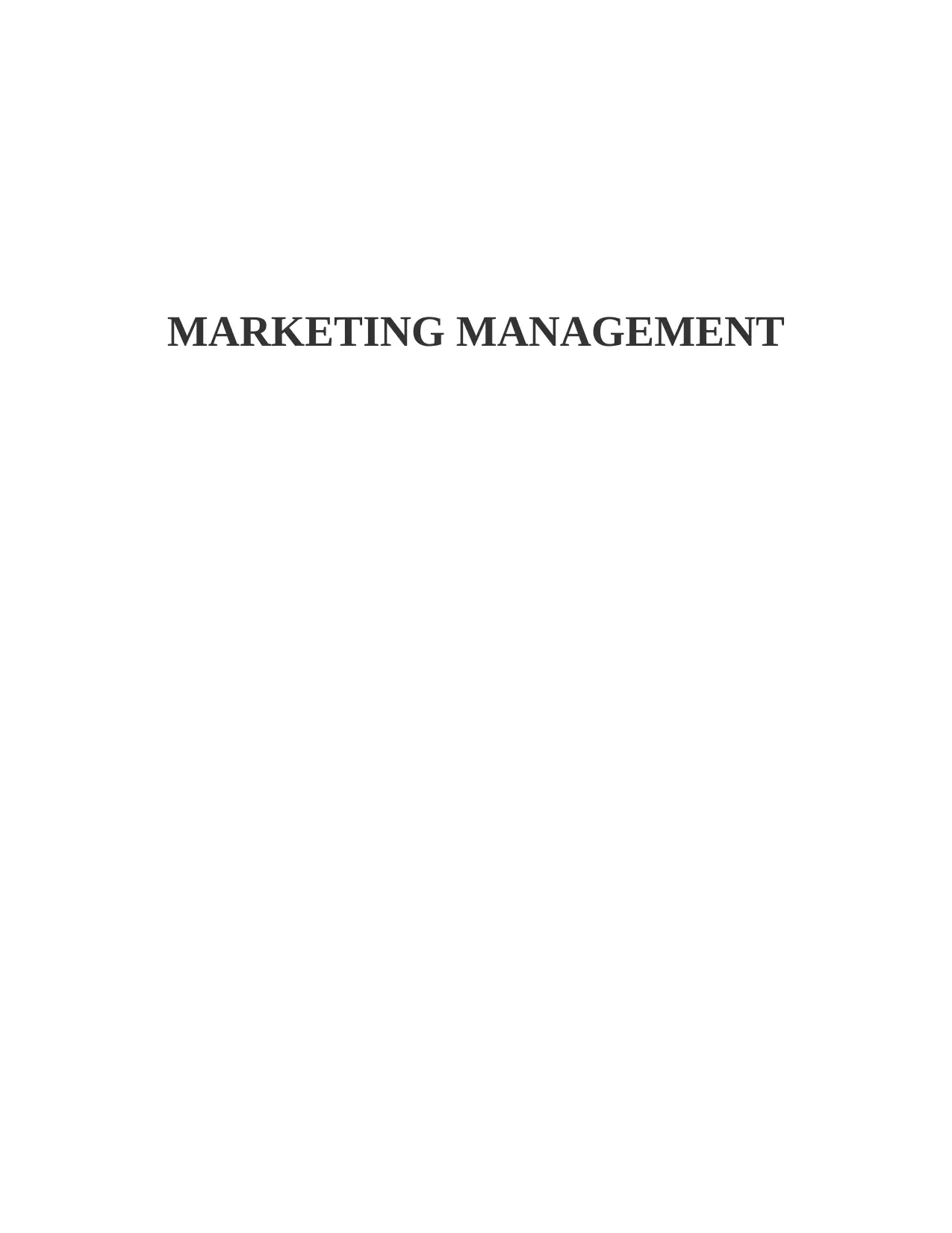
MARKETING MANAGEMENT
Secure Best Marks with AI Grader
Need help grading? Try our AI Grader for instant feedback on your assignments.
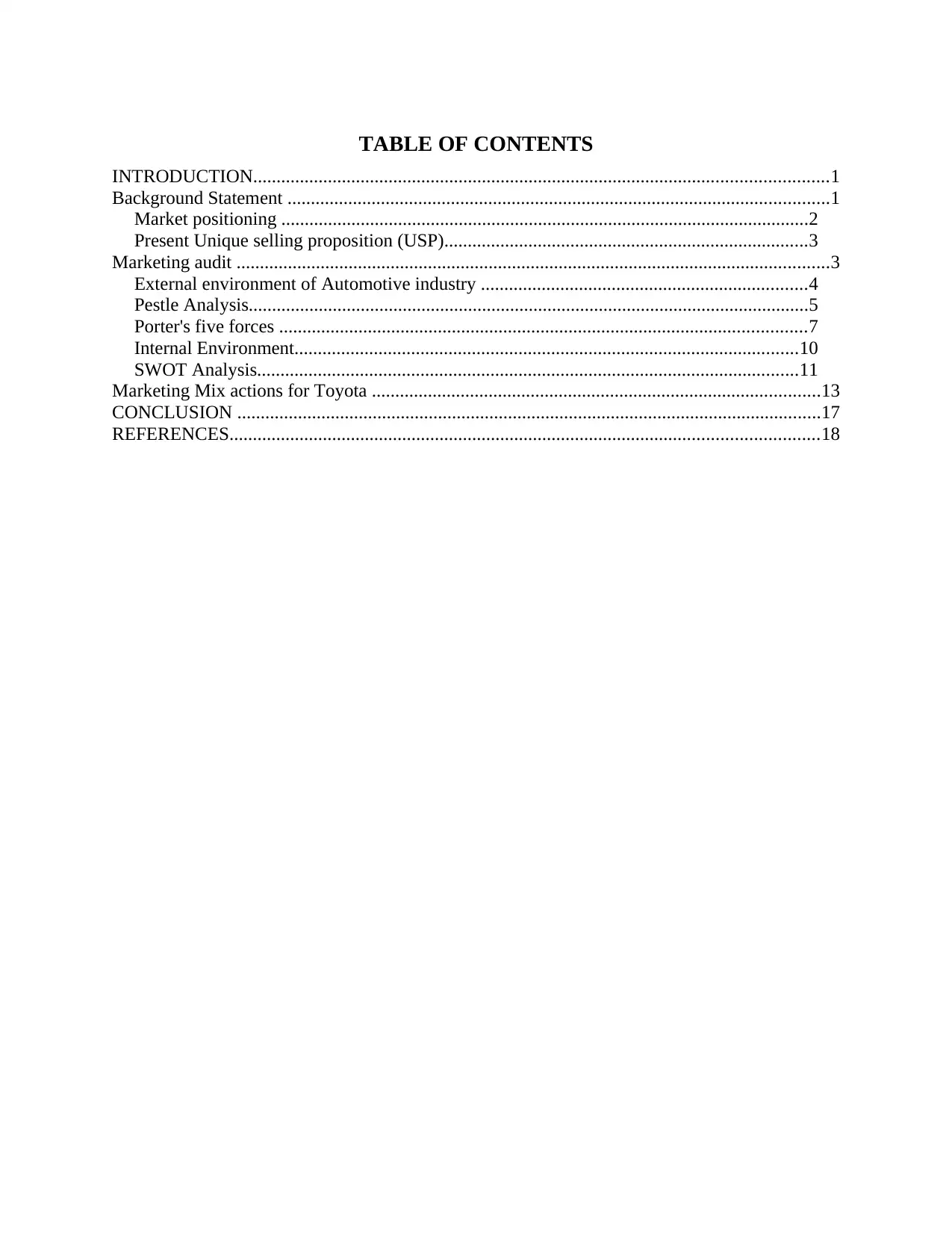
TABLE OF CONTENTS
INTRODUCTION...........................................................................................................................1
Background Statement ....................................................................................................................1
Market positioning .................................................................................................................2
Present Unique selling proposition (USP)..............................................................................3
Marketing audit ...............................................................................................................................3
External environment of Automotive industry ......................................................................4
Pestle Analysis........................................................................................................................5
Porter's five forces .................................................................................................................7
Internal Environment............................................................................................................10
SWOT Analysis....................................................................................................................11
Marketing Mix actions for Toyota ................................................................................................13
CONCLUSION .............................................................................................................................17
REFERENCES..............................................................................................................................18
INTRODUCTION...........................................................................................................................1
Background Statement ....................................................................................................................1
Market positioning .................................................................................................................2
Present Unique selling proposition (USP)..............................................................................3
Marketing audit ...............................................................................................................................3
External environment of Automotive industry ......................................................................4
Pestle Analysis........................................................................................................................5
Porter's five forces .................................................................................................................7
Internal Environment............................................................................................................10
SWOT Analysis....................................................................................................................11
Marketing Mix actions for Toyota ................................................................................................13
CONCLUSION .............................................................................................................................17
REFERENCES..............................................................................................................................18
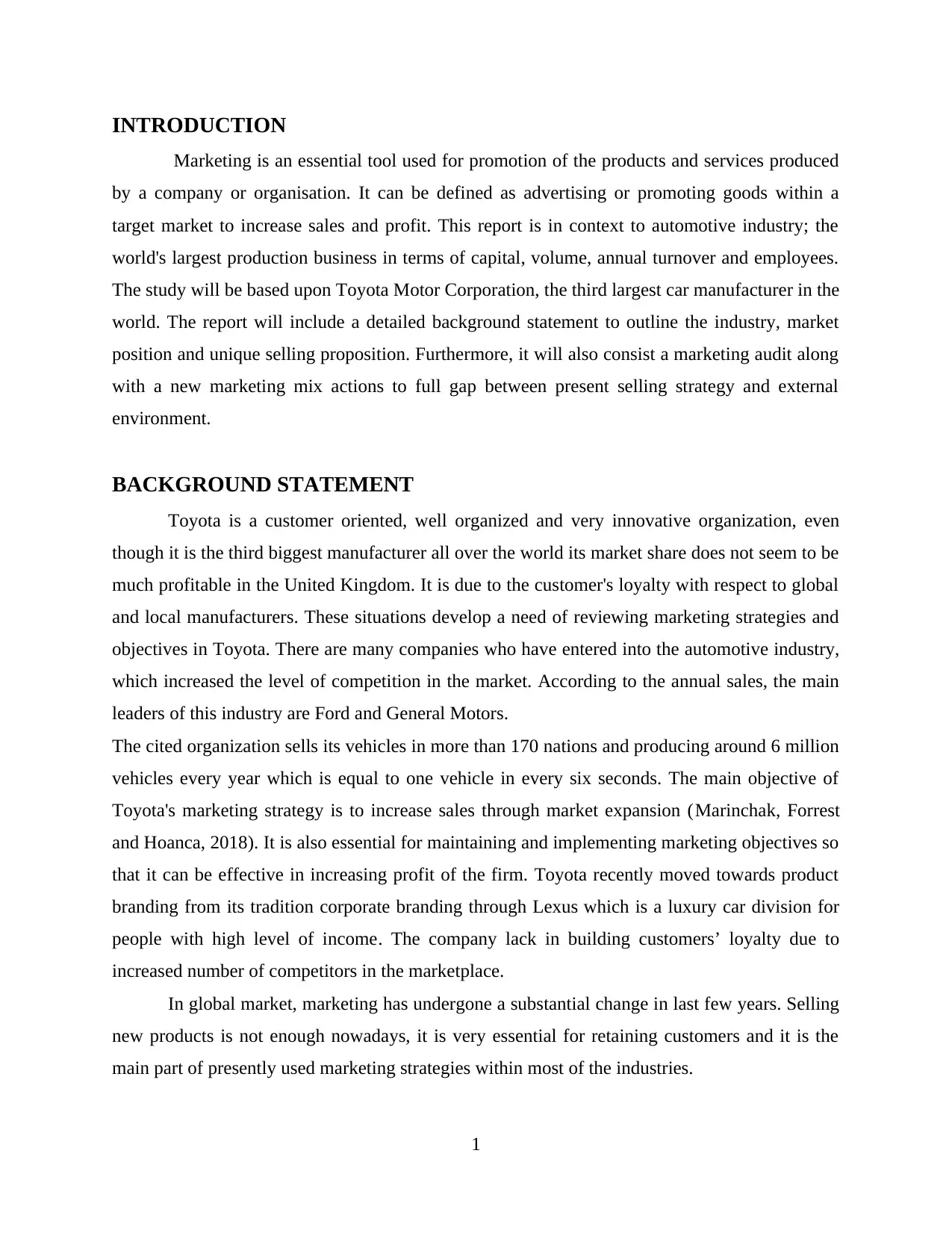
INTRODUCTION
Marketing is an essential tool used for promotion of the products and services produced
by a company or organisation. It can be defined as advertising or promoting goods within a
target market to increase sales and profit. This report is in context to automotive industry; the
world's largest production business in terms of capital, volume, annual turnover and employees.
The study will be based upon Toyota Motor Corporation, the third largest car manufacturer in the
world. The report will include a detailed background statement to outline the industry, market
position and unique selling proposition. Furthermore, it will also consist a marketing audit along
with a new marketing mix actions to full gap between present selling strategy and external
environment.
BACKGROUND STATEMENT
Toyota is a customer oriented, well organized and very innovative organization, even
though it is the third biggest manufacturer all over the world its market share does not seem to be
much profitable in the United Kingdom. It is due to the customer's loyalty with respect to global
and local manufacturers. These situations develop a need of reviewing marketing strategies and
objectives in Toyota. There are many companies who have entered into the automotive industry,
which increased the level of competition in the market. According to the annual sales, the main
leaders of this industry are Ford and General Motors.
The cited organization sells its vehicles in more than 170 nations and producing around 6 million
vehicles every year which is equal to one vehicle in every six seconds. The main objective of
Toyota's marketing strategy is to increase sales through market expansion (Marinchak, Forrest
and Hoanca, 2018). It is also essential for maintaining and implementing marketing objectives so
that it can be effective in increasing profit of the firm. Toyota recently moved towards product
branding from its tradition corporate branding through Lexus which is a luxury car division for
people with high level of income. The company lack in building customers’ loyalty due to
increased number of competitors in the marketplace.
In global market, marketing has undergone a substantial change in last few years. Selling
new products is not enough nowadays, it is very essential for retaining customers and it is the
main part of presently used marketing strategies within most of the industries.
1
Marketing is an essential tool used for promotion of the products and services produced
by a company or organisation. It can be defined as advertising or promoting goods within a
target market to increase sales and profit. This report is in context to automotive industry; the
world's largest production business in terms of capital, volume, annual turnover and employees.
The study will be based upon Toyota Motor Corporation, the third largest car manufacturer in the
world. The report will include a detailed background statement to outline the industry, market
position and unique selling proposition. Furthermore, it will also consist a marketing audit along
with a new marketing mix actions to full gap between present selling strategy and external
environment.
BACKGROUND STATEMENT
Toyota is a customer oriented, well organized and very innovative organization, even
though it is the third biggest manufacturer all over the world its market share does not seem to be
much profitable in the United Kingdom. It is due to the customer's loyalty with respect to global
and local manufacturers. These situations develop a need of reviewing marketing strategies and
objectives in Toyota. There are many companies who have entered into the automotive industry,
which increased the level of competition in the market. According to the annual sales, the main
leaders of this industry are Ford and General Motors.
The cited organization sells its vehicles in more than 170 nations and producing around 6 million
vehicles every year which is equal to one vehicle in every six seconds. The main objective of
Toyota's marketing strategy is to increase sales through market expansion (Marinchak, Forrest
and Hoanca, 2018). It is also essential for maintaining and implementing marketing objectives so
that it can be effective in increasing profit of the firm. Toyota recently moved towards product
branding from its tradition corporate branding through Lexus which is a luxury car division for
people with high level of income. The company lack in building customers’ loyalty due to
increased number of competitors in the marketplace.
In global market, marketing has undergone a substantial change in last few years. Selling
new products is not enough nowadays, it is very essential for retaining customers and it is the
main part of presently used marketing strategies within most of the industries.
1
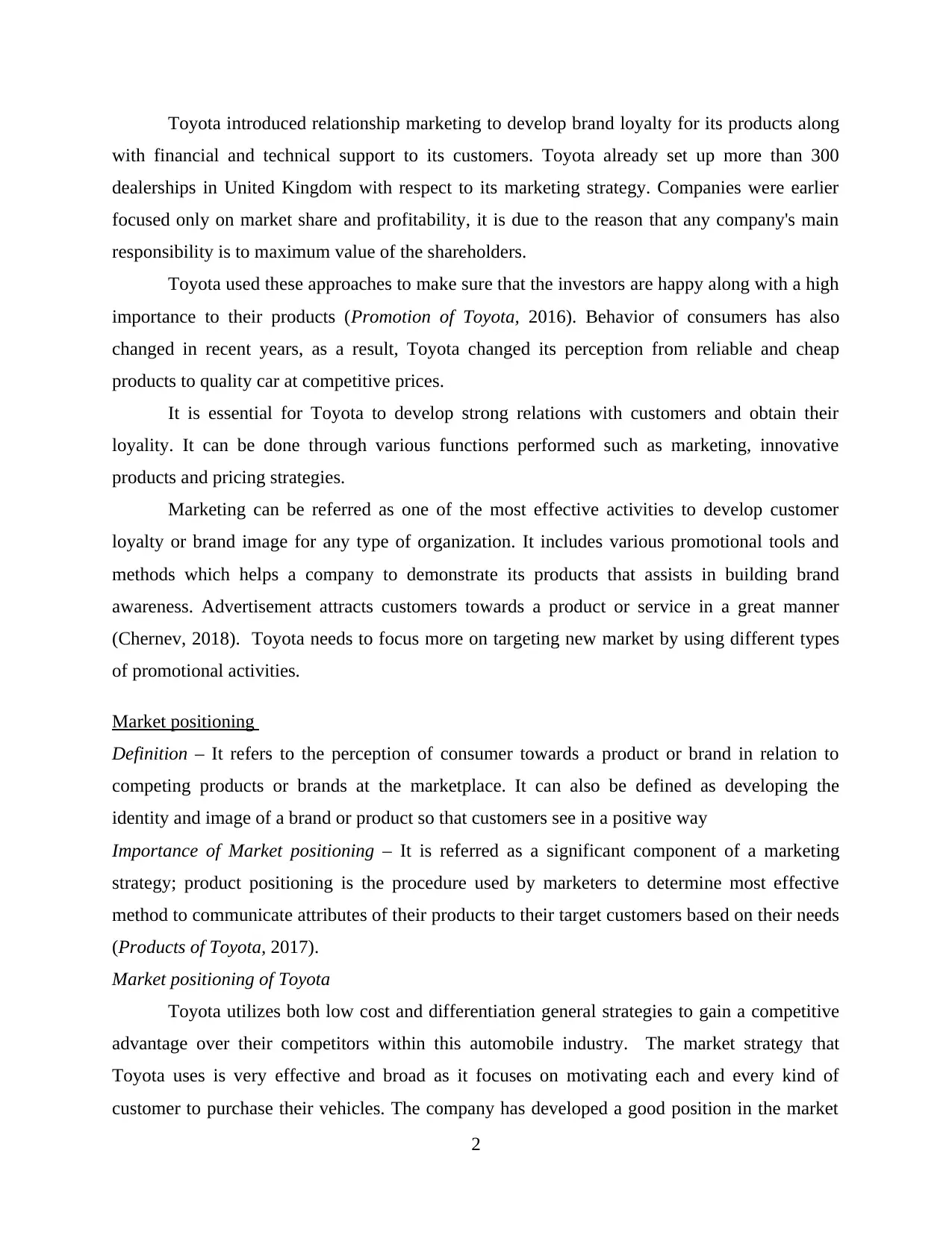
Toyota introduced relationship marketing to develop brand loyalty for its products along
with financial and technical support to its customers. Toyota already set up more than 300
dealerships in United Kingdom with respect to its marketing strategy. Companies were earlier
focused only on market share and profitability, it is due to the reason that any company's main
responsibility is to maximum value of the shareholders.
Toyota used these approaches to make sure that the investors are happy along with a high
importance to their products (Promotion of Toyota, 2016). Behavior of consumers has also
changed in recent years, as a result, Toyota changed its perception from reliable and cheap
products to quality car at competitive prices.
It is essential for Toyota to develop strong relations with customers and obtain their
loyality. It can be done through various functions performed such as marketing, innovative
products and pricing strategies.
Marketing can be referred as one of the most effective activities to develop customer
loyalty or brand image for any type of organization. It includes various promotional tools and
methods which helps a company to demonstrate its products that assists in building brand
awareness. Advertisement attracts customers towards a product or service in a great manner
(Chernev, 2018). Toyota needs to focus more on targeting new market by using different types
of promotional activities.
Market positioning
Definition – It refers to the perception of consumer towards a product or brand in relation to
competing products or brands at the marketplace. It can also be defined as developing the
identity and image of a brand or product so that customers see in a positive way
Importance of Market positioning – It is referred as a significant component of a marketing
strategy; product positioning is the procedure used by marketers to determine most effective
method to communicate attributes of their products to their target customers based on their needs
(Products of Toyota, 2017).
Market positioning of Toyota
Toyota utilizes both low cost and differentiation general strategies to gain a competitive
advantage over their competitors within this automobile industry. The market strategy that
Toyota uses is very effective and broad as it focuses on motivating each and every kind of
customer to purchase their vehicles. The company has developed a good position in the market
2
with financial and technical support to its customers. Toyota already set up more than 300
dealerships in United Kingdom with respect to its marketing strategy. Companies were earlier
focused only on market share and profitability, it is due to the reason that any company's main
responsibility is to maximum value of the shareholders.
Toyota used these approaches to make sure that the investors are happy along with a high
importance to their products (Promotion of Toyota, 2016). Behavior of consumers has also
changed in recent years, as a result, Toyota changed its perception from reliable and cheap
products to quality car at competitive prices.
It is essential for Toyota to develop strong relations with customers and obtain their
loyality. It can be done through various functions performed such as marketing, innovative
products and pricing strategies.
Marketing can be referred as one of the most effective activities to develop customer
loyalty or brand image for any type of organization. It includes various promotional tools and
methods which helps a company to demonstrate its products that assists in building brand
awareness. Advertisement attracts customers towards a product or service in a great manner
(Chernev, 2018). Toyota needs to focus more on targeting new market by using different types
of promotional activities.
Market positioning
Definition – It refers to the perception of consumer towards a product or brand in relation to
competing products or brands at the marketplace. It can also be defined as developing the
identity and image of a brand or product so that customers see in a positive way
Importance of Market positioning – It is referred as a significant component of a marketing
strategy; product positioning is the procedure used by marketers to determine most effective
method to communicate attributes of their products to their target customers based on their needs
(Products of Toyota, 2017).
Market positioning of Toyota
Toyota utilizes both low cost and differentiation general strategies to gain a competitive
advantage over their competitors within this automobile industry. The market strategy that
Toyota uses is very effective and broad as it focuses on motivating each and every kind of
customer to purchase their vehicles. The company has developed a good position in the market
2
Secure Best Marks with AI Grader
Need help grading? Try our AI Grader for instant feedback on your assignments.
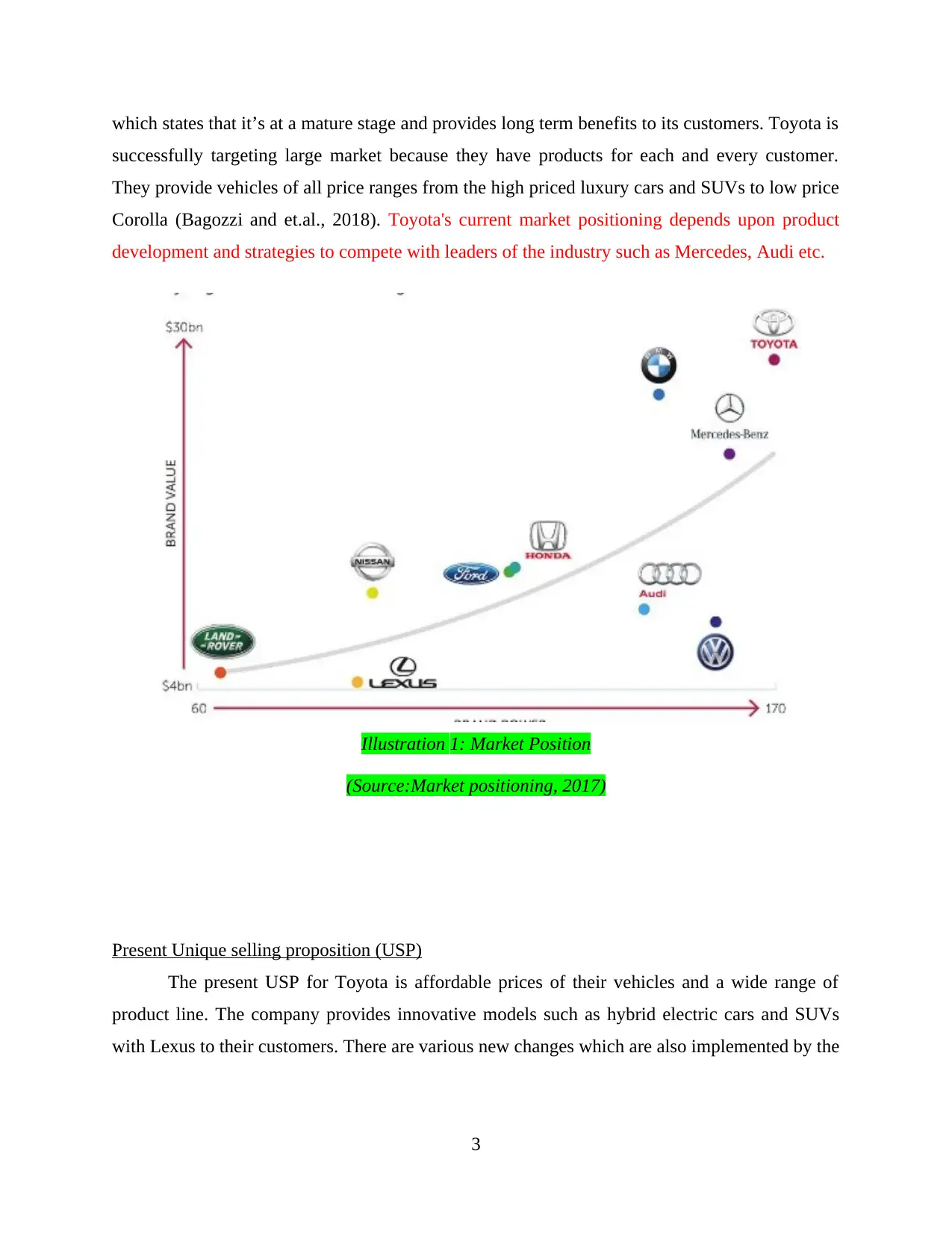
which states that it’s at a mature stage and provides long term benefits to its customers. Toyota is
successfully targeting large market because they have products for each and every customer.
They provide vehicles of all price ranges from the high priced luxury cars and SUVs to low price
Corolla (Bagozzi and et.al., 2018). Toyota's current market positioning depends upon product
development and strategies to compete with leaders of the industry such as Mercedes, Audi etc.
Present Unique selling proposition (USP)
The present USP for Toyota is affordable prices of their vehicles and a wide range of
product line. The company provides innovative models such as hybrid electric cars and SUVs
with Lexus to their customers. There are various new changes which are also implemented by the
3
Illustration 1: Market Position
(Source:Market positioning, 2017)
successfully targeting large market because they have products for each and every customer.
They provide vehicles of all price ranges from the high priced luxury cars and SUVs to low price
Corolla (Bagozzi and et.al., 2018). Toyota's current market positioning depends upon product
development and strategies to compete with leaders of the industry such as Mercedes, Audi etc.
Present Unique selling proposition (USP)
The present USP for Toyota is affordable prices of their vehicles and a wide range of
product line. The company provides innovative models such as hybrid electric cars and SUVs
with Lexus to their customers. There are various new changes which are also implemented by the
3
Illustration 1: Market Position
(Source:Market positioning, 2017)
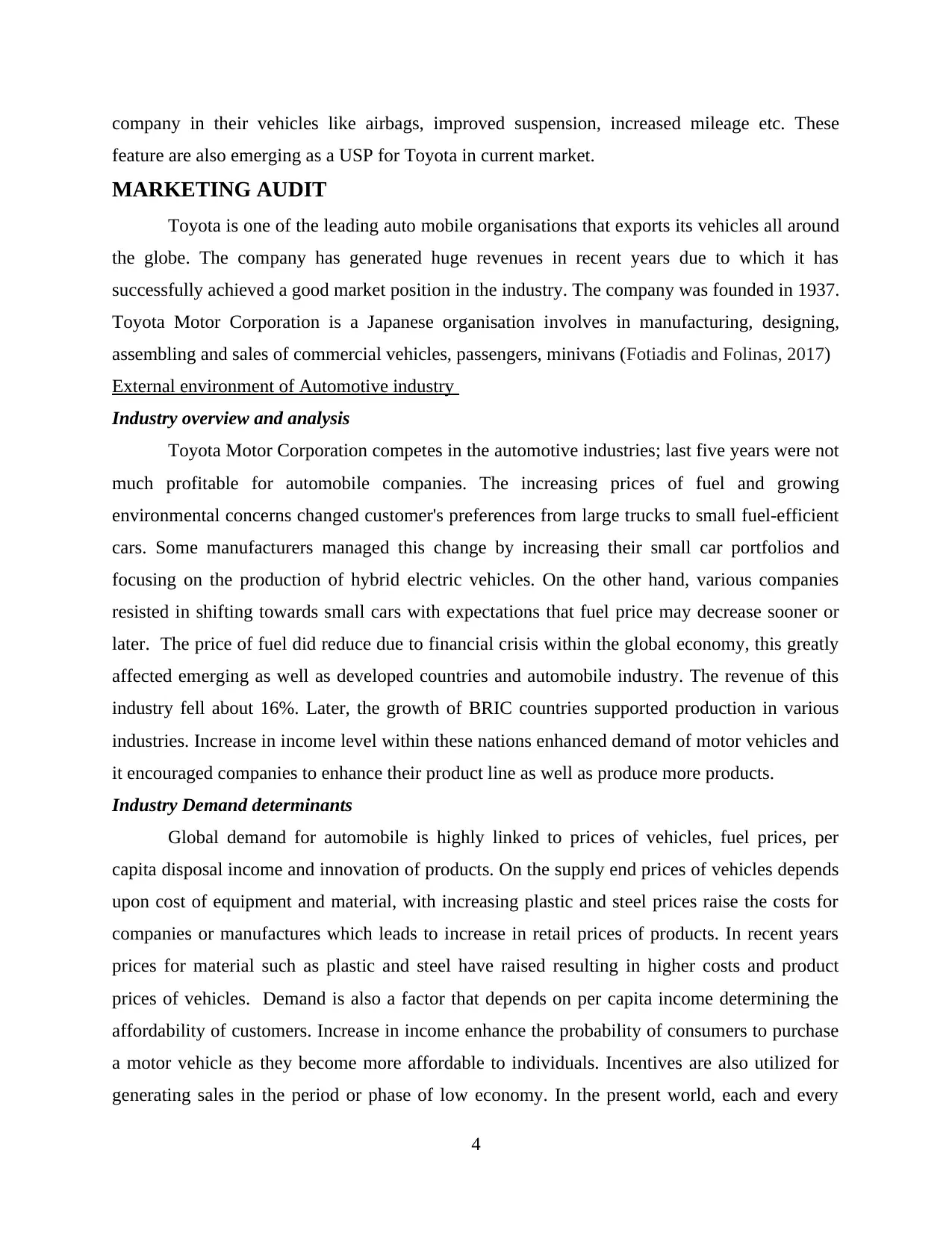
company in their vehicles like airbags, improved suspension, increased mileage etc. These
feature are also emerging as a USP for Toyota in current market.
MARKETING AUDIT
Toyota is one of the leading auto mobile organisations that exports its vehicles all around
the globe. The company has generated huge revenues in recent years due to which it has
successfully achieved a good market position in the industry. The company was founded in 1937.
Toyota Motor Corporation is a Japanese organisation involves in manufacturing, designing,
assembling and sales of commercial vehicles, passengers, minivans (Fotiadis and Folinas, 2017)
External environment of Automotive industry
Industry overview and analysis
Toyota Motor Corporation competes in the automotive industries; last five years were not
much profitable for automobile companies. The increasing prices of fuel and growing
environmental concerns changed customer's preferences from large trucks to small fuel-efficient
cars. Some manufacturers managed this change by increasing their small car portfolios and
focusing on the production of hybrid electric vehicles. On the other hand, various companies
resisted in shifting towards small cars with expectations that fuel price may decrease sooner or
later. The price of fuel did reduce due to financial crisis within the global economy, this greatly
affected emerging as well as developed countries and automobile industry. The revenue of this
industry fell about 16%. Later, the growth of BRIC countries supported production in various
industries. Increase in income level within these nations enhanced demand of motor vehicles and
it encouraged companies to enhance their product line as well as produce more products.
Industry Demand determinants
Global demand for automobile is highly linked to prices of vehicles, fuel prices, per
capita disposal income and innovation of products. On the supply end prices of vehicles depends
upon cost of equipment and material, with increasing plastic and steel prices raise the costs for
companies or manufactures which leads to increase in retail prices of products. In recent years
prices for material such as plastic and steel have raised resulting in higher costs and product
prices of vehicles. Demand is also a factor that depends on per capita income determining the
affordability of customers. Increase in income enhance the probability of consumers to purchase
a motor vehicle as they become more affordable to individuals. Incentives are also utilized for
generating sales in the period or phase of low economy. In the present world, each and every
4
feature are also emerging as a USP for Toyota in current market.
MARKETING AUDIT
Toyota is one of the leading auto mobile organisations that exports its vehicles all around
the globe. The company has generated huge revenues in recent years due to which it has
successfully achieved a good market position in the industry. The company was founded in 1937.
Toyota Motor Corporation is a Japanese organisation involves in manufacturing, designing,
assembling and sales of commercial vehicles, passengers, minivans (Fotiadis and Folinas, 2017)
External environment of Automotive industry
Industry overview and analysis
Toyota Motor Corporation competes in the automotive industries; last five years were not
much profitable for automobile companies. The increasing prices of fuel and growing
environmental concerns changed customer's preferences from large trucks to small fuel-efficient
cars. Some manufacturers managed this change by increasing their small car portfolios and
focusing on the production of hybrid electric vehicles. On the other hand, various companies
resisted in shifting towards small cars with expectations that fuel price may decrease sooner or
later. The price of fuel did reduce due to financial crisis within the global economy, this greatly
affected emerging as well as developed countries and automobile industry. The revenue of this
industry fell about 16%. Later, the growth of BRIC countries supported production in various
industries. Increase in income level within these nations enhanced demand of motor vehicles and
it encouraged companies to enhance their product line as well as produce more products.
Industry Demand determinants
Global demand for automobile is highly linked to prices of vehicles, fuel prices, per
capita disposal income and innovation of products. On the supply end prices of vehicles depends
upon cost of equipment and material, with increasing plastic and steel prices raise the costs for
companies or manufactures which leads to increase in retail prices of products. In recent years
prices for material such as plastic and steel have raised resulting in higher costs and product
prices of vehicles. Demand is also a factor that depends on per capita income determining the
affordability of customers. Increase in income enhance the probability of consumers to purchase
a motor vehicle as they become more affordable to individuals. Incentives are also utilized for
generating sales in the period or phase of low economy. In the present world, each and every
4

company focuses on improving the quality which encouraged customers to differentiate similar
products on the basis their prices. Fluctuation in fuel prices also affects the demand of vehicles
with respect to their types. The demand for fuel efficient cars increases during the period of high
prices of fuel. Product innovation can also influence demand of motor vehicles mainly related to
more fuel efficient vehicles such as electric and hybrid models (Arkadan, Macdonald and
Wilson, 2017). These models highly customers as they will be interested in investing for a new
care for savings on cost of fuel while using a vehicle.
Pestle Analysis
Automotive companies all around the world are facing a huge number of issues and
pressures while performing their functions effectively. The end of economic recession has raised
sales and profitability, however there are various other factors which are also influencing
automobile industry.
Self- driving technology which is developed recently is already developing a great
excitement among car manufacturers such as Toyota and Ford. The companies are already
making heavy investment in this technology to gain competitive advantage among the
competitors. Politics, Global economy and other factors influence business of Toyota.
Other than these factors, competition is also an important element and the increased
interest of customers in EVs is also influencing vehicle manufacturer (Zahari and Romli, 2018).
Pestle analysis can be used for evaluating various components in External Environment
that outline and affects market attractiveness.
1. Political - Political factors are kept growing in significance with globalization, whether
the country's environment is good for business or not is highly depended upon the level
of governmental stability in that particular nation. The success of international brand to
do business in various countries also depends upon the government and policies. Political
stability refers to a calm environment appropriate to perform business activities.
Fluctuating policies and political disturbance leads to disruption in business as well as
supply chain and distribution network. In order to overcome this issue Toyota focuses on
global markets and countries having stable political environment such as Asia to
successfully m market their products and increase its revenue.
5
products on the basis their prices. Fluctuation in fuel prices also affects the demand of vehicles
with respect to their types. The demand for fuel efficient cars increases during the period of high
prices of fuel. Product innovation can also influence demand of motor vehicles mainly related to
more fuel efficient vehicles such as electric and hybrid models (Arkadan, Macdonald and
Wilson, 2017). These models highly customers as they will be interested in investing for a new
care for savings on cost of fuel while using a vehicle.
Pestle Analysis
Automotive companies all around the world are facing a huge number of issues and
pressures while performing their functions effectively. The end of economic recession has raised
sales and profitability, however there are various other factors which are also influencing
automobile industry.
Self- driving technology which is developed recently is already developing a great
excitement among car manufacturers such as Toyota and Ford. The companies are already
making heavy investment in this technology to gain competitive advantage among the
competitors. Politics, Global economy and other factors influence business of Toyota.
Other than these factors, competition is also an important element and the increased
interest of customers in EVs is also influencing vehicle manufacturer (Zahari and Romli, 2018).
Pestle analysis can be used for evaluating various components in External Environment
that outline and affects market attractiveness.
1. Political - Political factors are kept growing in significance with globalization, whether
the country's environment is good for business or not is highly depended upon the level
of governmental stability in that particular nation. The success of international brand to
do business in various countries also depends upon the government and policies. Political
stability refers to a calm environment appropriate to perform business activities.
Fluctuating policies and political disturbance leads to disruption in business as well as
supply chain and distribution network. In order to overcome this issue Toyota focuses on
global markets and countries having stable political environment such as Asia to
successfully m market their products and increase its revenue.
5
Paraphrase This Document
Need a fresh take? Get an instant paraphrase of this document with our AI Paraphraser

2. Economic - The relation between market and economic conditions is very well known
due to its potential in developing relationships with new markets. Better economic
conditions such as increased per capita income, inflation etc globally develop a better
situation of the global market, after the end of economical recession economy of the
world is growing very fast. Particularly, the Asian region is leading in this regard. Most
of the manufacturers of vehicles are focuses on this region for higher profits and faster
growth. Some countries are still trying to emerge from economic slowdown. Better
economic condition refers to higher level employment which leads to higher purchasing
power of the customers. Higher level of purchasing power of the customers’ result in
increased profits and sales for international brands such as Toyota. Better economic
activity may also lead to increased income for individuals by development of business or
industries, high rate of employment etc. (Zoo, Lee and Yoon, 2017).
3. Social - Social and cultural trends & forces have a major effect on the sales of global
organizations. International marketplace is created from various smaller markets where
social and cultural factors can become barriers. This is the reason why brands give
importance to local customers through localization in regional markets. Social trends
such as changing preferences, design or cars, accessories etc also influence business of
the companies directly. Environment friendly and electrical vehicles are getting popular
nowadays, their sales ratio have enhanced fast in recent years. Global sales have reached
9 million units for Toyota hybrid vehicles as of March 31, 2016 after the sales launch of
the Prius, which was the first mass-produced hybrid passenger vehicle in the world.
4. Technological - Technology is continuously growing in each and every area of
organization in the 21st century. Various companies are utilizing IT in different areas to
grow and develop their business activities and manage them effectively. The automobile
industry is highly dependent on technologies, the better a technology in a brand the
higher are their sales (Bresler and Lubbe, 2014). From rider's convenience to safety of the
passenger, in every area technology plays a significant role and influence popularity of a
brand, Toyota effectively invest o using most innovative technologies such as hybrid and
electric system, low emission in their vehicles to attract more customers and achieve
success in various market all around the world.
6
due to its potential in developing relationships with new markets. Better economic
conditions such as increased per capita income, inflation etc globally develop a better
situation of the global market, after the end of economical recession economy of the
world is growing very fast. Particularly, the Asian region is leading in this regard. Most
of the manufacturers of vehicles are focuses on this region for higher profits and faster
growth. Some countries are still trying to emerge from economic slowdown. Better
economic condition refers to higher level employment which leads to higher purchasing
power of the customers. Higher level of purchasing power of the customers’ result in
increased profits and sales for international brands such as Toyota. Better economic
activity may also lead to increased income for individuals by development of business or
industries, high rate of employment etc. (Zoo, Lee and Yoon, 2017).
3. Social - Social and cultural trends & forces have a major effect on the sales of global
organizations. International marketplace is created from various smaller markets where
social and cultural factors can become barriers. This is the reason why brands give
importance to local customers through localization in regional markets. Social trends
such as changing preferences, design or cars, accessories etc also influence business of
the companies directly. Environment friendly and electrical vehicles are getting popular
nowadays, their sales ratio have enhanced fast in recent years. Global sales have reached
9 million units for Toyota hybrid vehicles as of March 31, 2016 after the sales launch of
the Prius, which was the first mass-produced hybrid passenger vehicle in the world.
4. Technological - Technology is continuously growing in each and every area of
organization in the 21st century. Various companies are utilizing IT in different areas to
grow and develop their business activities and manage them effectively. The automobile
industry is highly dependent on technologies, the better a technology in a brand the
higher are their sales (Bresler and Lubbe, 2014). From rider's convenience to safety of the
passenger, in every area technology plays a significant role and influence popularity of a
brand, Toyota effectively invest o using most innovative technologies such as hybrid and
electric system, low emission in their vehicles to attract more customers and achieve
success in various market all around the world.
6
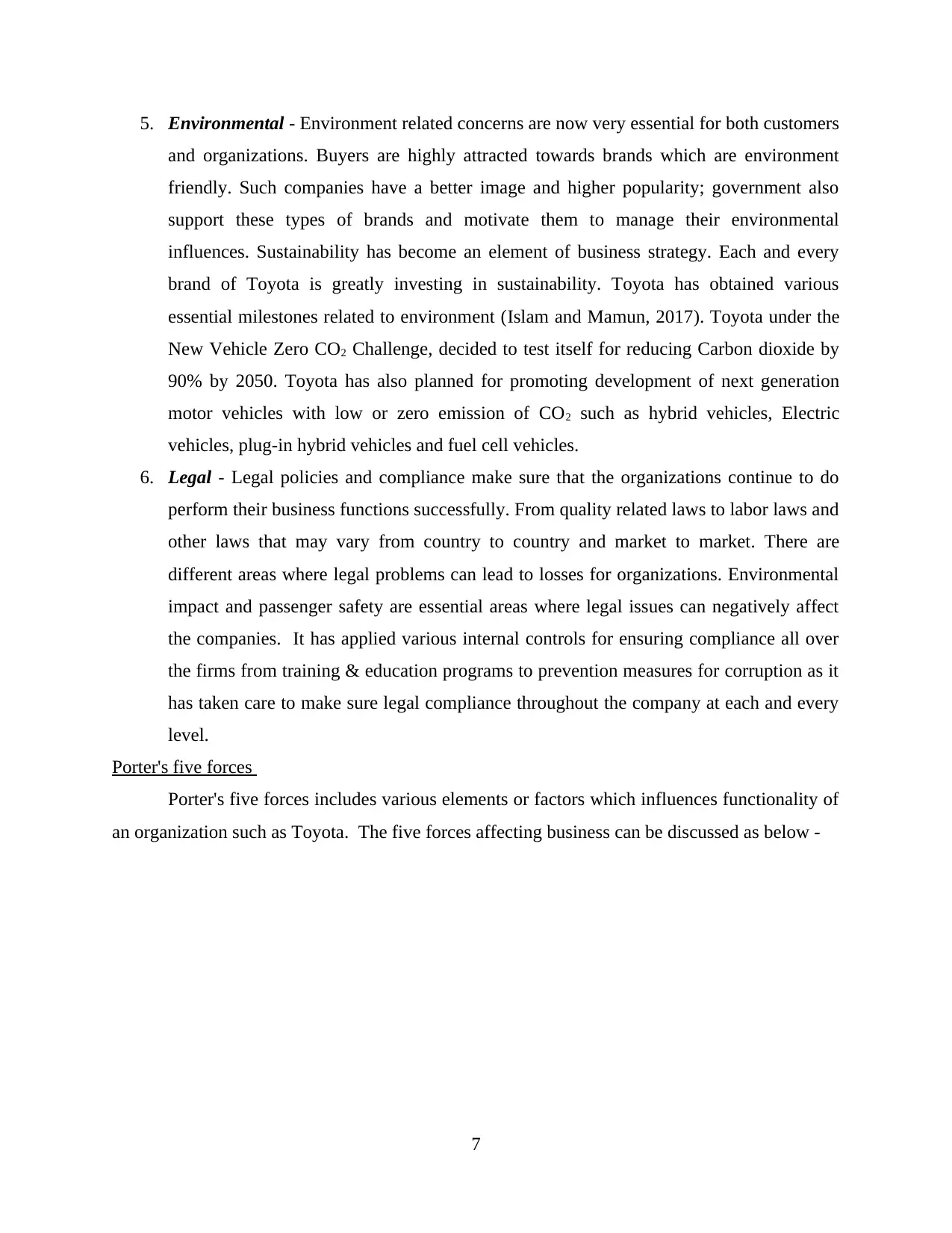
5. Environmental - Environment related concerns are now very essential for both customers
and organizations. Buyers are highly attracted towards brands which are environment
friendly. Such companies have a better image and higher popularity; government also
support these types of brands and motivate them to manage their environmental
influences. Sustainability has become an element of business strategy. Each and every
brand of Toyota is greatly investing in sustainability. Toyota has obtained various
essential milestones related to environment (Islam and Mamun, 2017). Toyota under the
New Vehicle Zero CO2 Challenge, decided to test itself for reducing Carbon dioxide by
90% by 2050. Toyota has also planned for promoting development of next generation
motor vehicles with low or zero emission of CO2 such as hybrid vehicles, Electric
vehicles, plug-in hybrid vehicles and fuel cell vehicles.
6. Legal - Legal policies and compliance make sure that the organizations continue to do
perform their business functions successfully. From quality related laws to labor laws and
other laws that may vary from country to country and market to market. There are
different areas where legal problems can lead to losses for organizations. Environmental
impact and passenger safety are essential areas where legal issues can negatively affect
the companies. It has applied various internal controls for ensuring compliance all over
the firms from training & education programs to prevention measures for corruption as it
has taken care to make sure legal compliance throughout the company at each and every
level.
Porter's five forces
Porter's five forces includes various elements or factors which influences functionality of
an organization such as Toyota. The five forces affecting business can be discussed as below -
7
and organizations. Buyers are highly attracted towards brands which are environment
friendly. Such companies have a better image and higher popularity; government also
support these types of brands and motivate them to manage their environmental
influences. Sustainability has become an element of business strategy. Each and every
brand of Toyota is greatly investing in sustainability. Toyota has obtained various
essential milestones related to environment (Islam and Mamun, 2017). Toyota under the
New Vehicle Zero CO2 Challenge, decided to test itself for reducing Carbon dioxide by
90% by 2050. Toyota has also planned for promoting development of next generation
motor vehicles with low or zero emission of CO2 such as hybrid vehicles, Electric
vehicles, plug-in hybrid vehicles and fuel cell vehicles.
6. Legal - Legal policies and compliance make sure that the organizations continue to do
perform their business functions successfully. From quality related laws to labor laws and
other laws that may vary from country to country and market to market. There are
different areas where legal problems can lead to losses for organizations. Environmental
impact and passenger safety are essential areas where legal issues can negatively affect
the companies. It has applied various internal controls for ensuring compliance all over
the firms from training & education programs to prevention measures for corruption as it
has taken care to make sure legal compliance throughout the company at each and every
level.
Porter's five forces
Porter's five forces includes various elements or factors which influences functionality of
an organization such as Toyota. The five forces affecting business can be discussed as below -
7
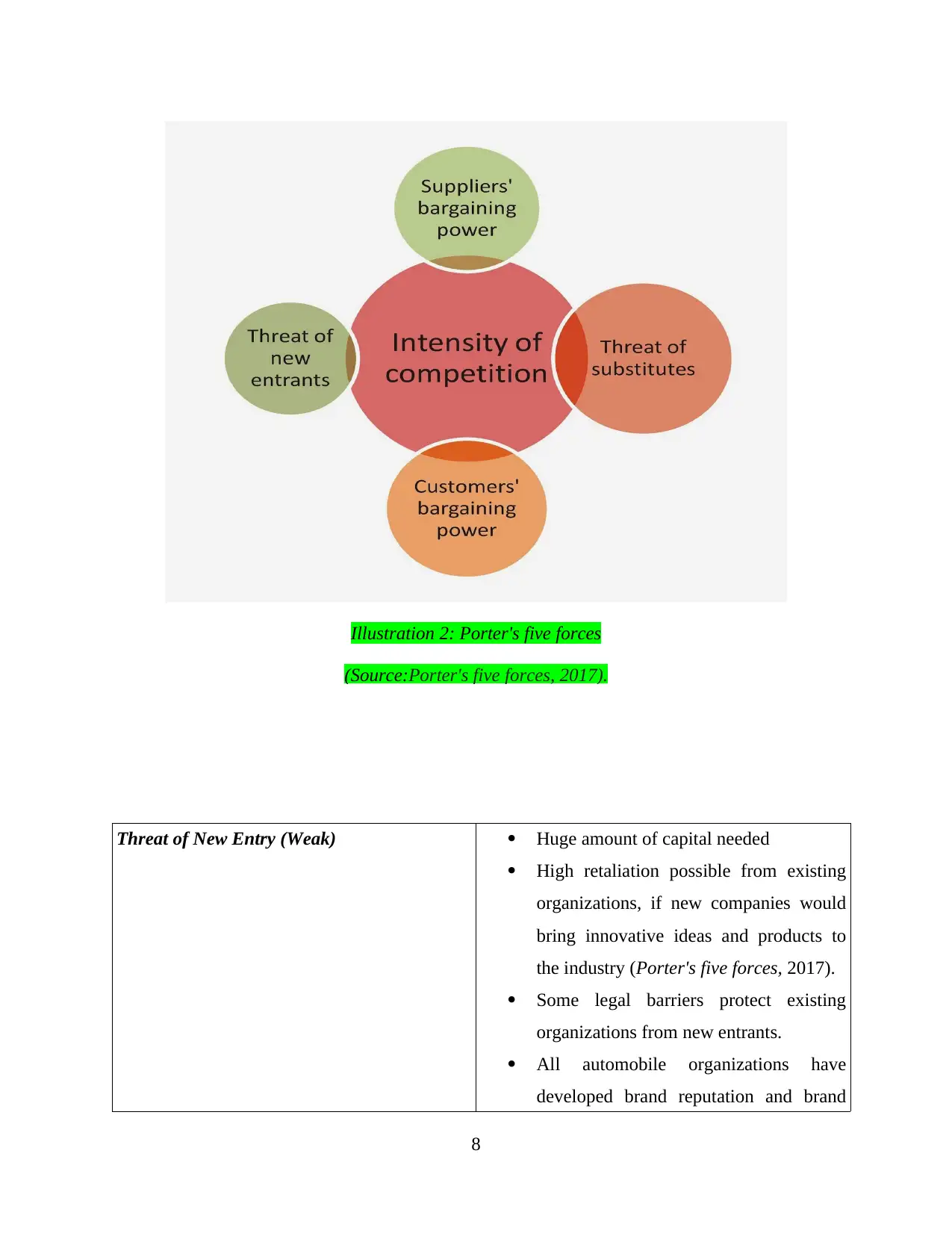
Threat of New Entry (Weak) Huge amount of capital needed
High retaliation possible from existing
organizations, if new companies would
bring innovative ideas and products to
the industry (Porter's five forces, 2017).
Some legal barriers protect existing
organizations from new entrants.
All automobile organizations have
developed brand reputation and brand
8
Illustration 2: Porter's five forces
(Source:Porter's five forces, 2017).
High retaliation possible from existing
organizations, if new companies would
bring innovative ideas and products to
the industry (Porter's five forces, 2017).
Some legal barriers protect existing
organizations from new entrants.
All automobile organizations have
developed brand reputation and brand
8
Illustration 2: Porter's five forces
(Source:Porter's five forces, 2017).
Secure Best Marks with AI Grader
Need help grading? Try our AI Grader for instant feedback on your assignments.
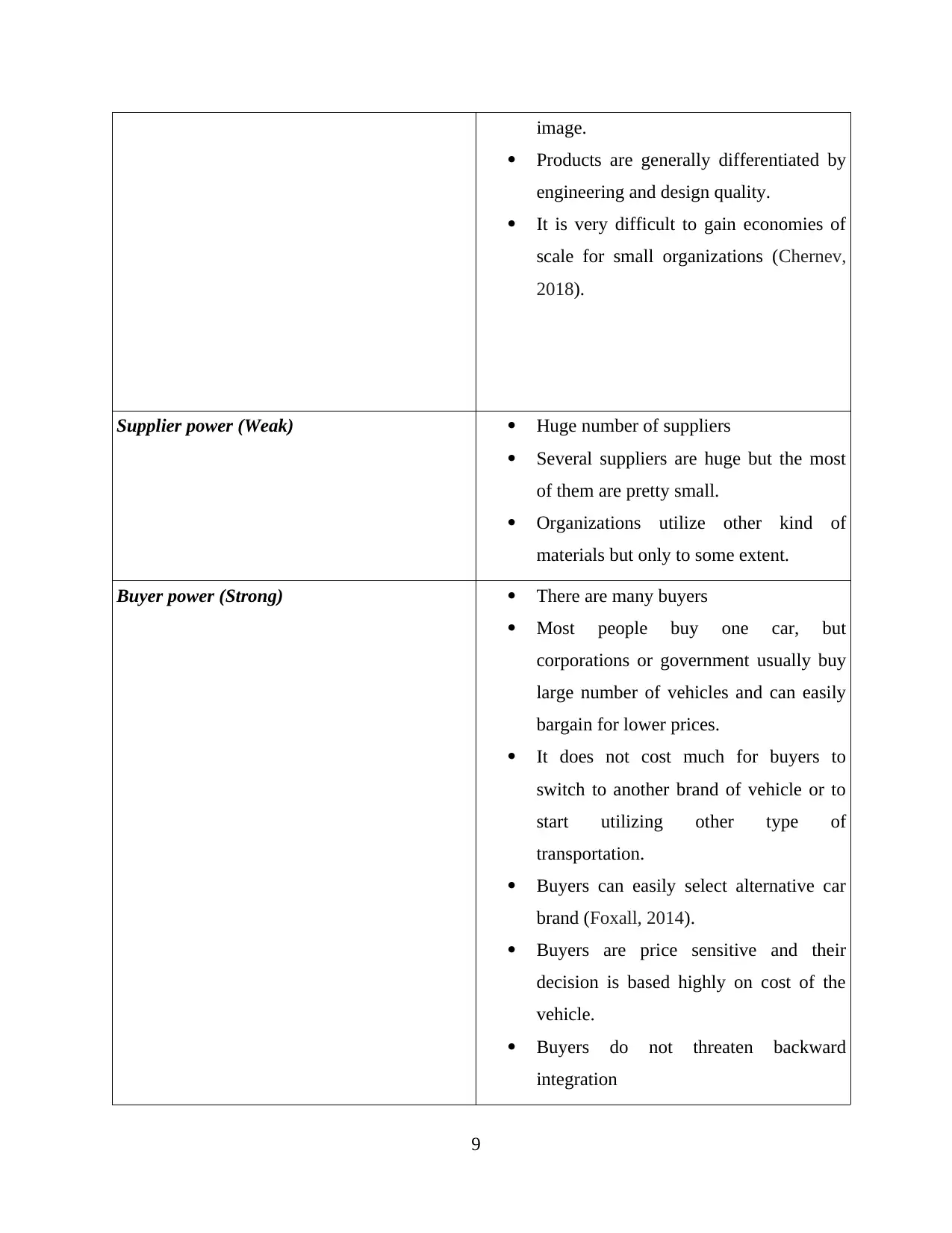
image.
Products are generally differentiated by
engineering and design quality.
It is very difficult to gain economies of
scale for small organizations (Chernev,
2018).
Supplier power (Weak) Huge number of suppliers
Several suppliers are huge but the most
of them are pretty small.
Organizations utilize other kind of
materials but only to some extent.
Buyer power (Strong) There are many buyers
Most people buy one car, but
corporations or government usually buy
large number of vehicles and can easily
bargain for lower prices.
It does not cost much for buyers to
switch to another brand of vehicle or to
start utilizing other type of
transportation.
Buyers can easily select alternative car
brand (Foxall, 2014).
Buyers are price sensitive and their
decision is based highly on cost of the
vehicle.
Buyers do not threaten backward
integration
9
Products are generally differentiated by
engineering and design quality.
It is very difficult to gain economies of
scale for small organizations (Chernev,
2018).
Supplier power (Weak) Huge number of suppliers
Several suppliers are huge but the most
of them are pretty small.
Organizations utilize other kind of
materials but only to some extent.
Buyer power (Strong) There are many buyers
Most people buy one car, but
corporations or government usually buy
large number of vehicles and can easily
bargain for lower prices.
It does not cost much for buyers to
switch to another brand of vehicle or to
start utilizing other type of
transportation.
Buyers can easily select alternative car
brand (Foxall, 2014).
Buyers are price sensitive and their
decision is based highly on cost of the
vehicle.
Buyers do not threaten backward
integration
9
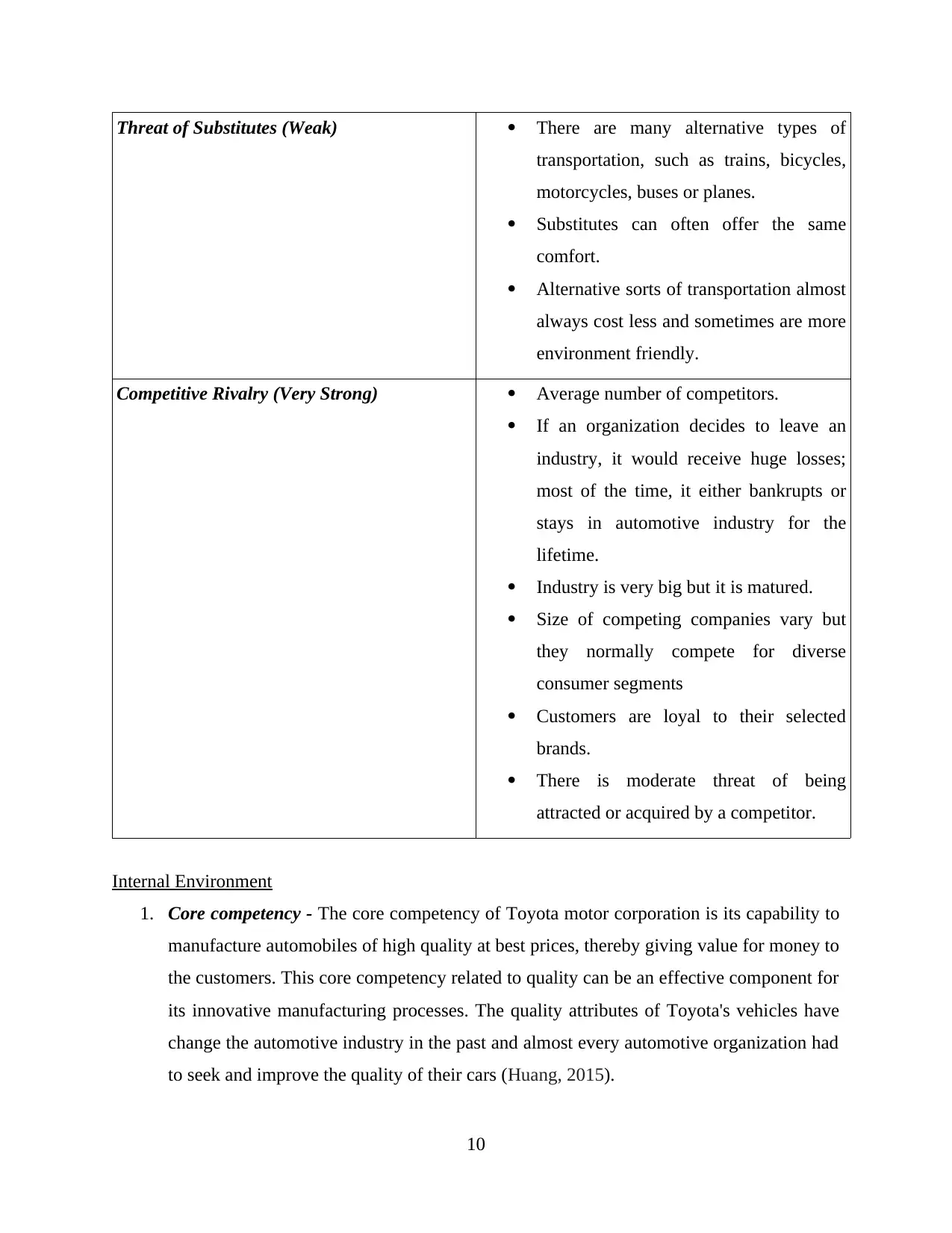
Threat of Substitutes (Weak) There are many alternative types of
transportation, such as trains, bicycles,
motorcycles, buses or planes.
Substitutes can often offer the same
comfort.
Alternative sorts of transportation almost
always cost less and sometimes are more
environment friendly.
Competitive Rivalry (Very Strong) Average number of competitors.
If an organization decides to leave an
industry, it would receive huge losses;
most of the time, it either bankrupts or
stays in automotive industry for the
lifetime.
Industry is very big but it is matured.
Size of competing companies vary but
they normally compete for diverse
consumer segments
Customers are loyal to their selected
brands.
There is moderate threat of being
attracted or acquired by a competitor.
Internal Environment
1. Core competency - The core competency of Toyota motor corporation is its capability to
manufacture automobiles of high quality at best prices, thereby giving value for money to
the customers. This core competency related to quality can be an effective component for
its innovative manufacturing processes. The quality attributes of Toyota's vehicles have
change the automotive industry in the past and almost every automotive organization had
to seek and improve the quality of their cars (Huang, 2015).
10
transportation, such as trains, bicycles,
motorcycles, buses or planes.
Substitutes can often offer the same
comfort.
Alternative sorts of transportation almost
always cost less and sometimes are more
environment friendly.
Competitive Rivalry (Very Strong) Average number of competitors.
If an organization decides to leave an
industry, it would receive huge losses;
most of the time, it either bankrupts or
stays in automotive industry for the
lifetime.
Industry is very big but it is matured.
Size of competing companies vary but
they normally compete for diverse
consumer segments
Customers are loyal to their selected
brands.
There is moderate threat of being
attracted or acquired by a competitor.
Internal Environment
1. Core competency - The core competency of Toyota motor corporation is its capability to
manufacture automobiles of high quality at best prices, thereby giving value for money to
the customers. This core competency related to quality can be an effective component for
its innovative manufacturing processes. The quality attributes of Toyota's vehicles have
change the automotive industry in the past and almost every automotive organization had
to seek and improve the quality of their cars (Huang, 2015).
10
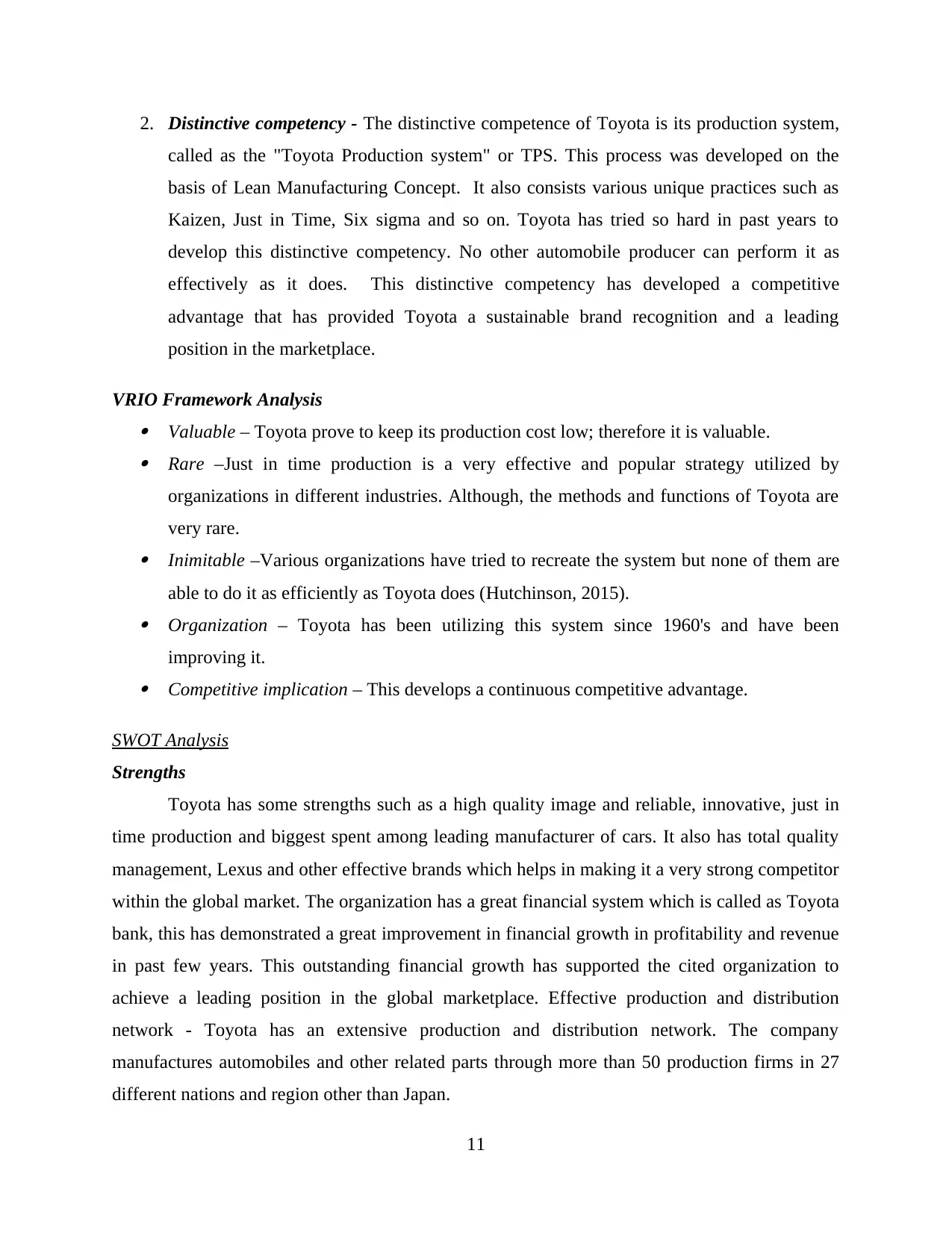
2. Distinctive competency - The distinctive competence of Toyota is its production system,
called as the "Toyota Production system" or TPS. This process was developed on the
basis of Lean Manufacturing Concept. It also consists various unique practices such as
Kaizen, Just in Time, Six sigma and so on. Toyota has tried so hard in past years to
develop this distinctive competency. No other automobile producer can perform it as
effectively as it does. This distinctive competency has developed a competitive
advantage that has provided Toyota a sustainable brand recognition and a leading
position in the marketplace.
VRIO Framework Analysis Valuable – Toyota prove to keep its production cost low; therefore it is valuable. Rare –Just in time production is a very effective and popular strategy utilized by
organizations in different industries. Although, the methods and functions of Toyota are
very rare. Inimitable –Various organizations have tried to recreate the system but none of them are
able to do it as efficiently as Toyota does (Hutchinson, 2015). Organization – Toyota has been utilizing this system since 1960's and have been
improving it. Competitive implication – This develops a continuous competitive advantage.
SWOT Analysis
Strengths
Toyota has some strengths such as a high quality image and reliable, innovative, just in
time production and biggest spent among leading manufacturer of cars. It also has total quality
management, Lexus and other effective brands which helps in making it a very strong competitor
within the global market. The organization has a great financial system which is called as Toyota
bank, this has demonstrated a great improvement in financial growth in profitability and revenue
in past few years. This outstanding financial growth has supported the cited organization to
achieve a leading position in the global marketplace. Effective production and distribution
network - Toyota has an extensive production and distribution network. The company
manufactures automobiles and other related parts through more than 50 production firms in 27
different nations and region other than Japan.
11
called as the "Toyota Production system" or TPS. This process was developed on the
basis of Lean Manufacturing Concept. It also consists various unique practices such as
Kaizen, Just in Time, Six sigma and so on. Toyota has tried so hard in past years to
develop this distinctive competency. No other automobile producer can perform it as
effectively as it does. This distinctive competency has developed a competitive
advantage that has provided Toyota a sustainable brand recognition and a leading
position in the marketplace.
VRIO Framework Analysis Valuable – Toyota prove to keep its production cost low; therefore it is valuable. Rare –Just in time production is a very effective and popular strategy utilized by
organizations in different industries. Although, the methods and functions of Toyota are
very rare. Inimitable –Various organizations have tried to recreate the system but none of them are
able to do it as efficiently as Toyota does (Hutchinson, 2015). Organization – Toyota has been utilizing this system since 1960's and have been
improving it. Competitive implication – This develops a continuous competitive advantage.
SWOT Analysis
Strengths
Toyota has some strengths such as a high quality image and reliable, innovative, just in
time production and biggest spent among leading manufacturer of cars. It also has total quality
management, Lexus and other effective brands which helps in making it a very strong competitor
within the global market. The organization has a great financial system which is called as Toyota
bank, this has demonstrated a great improvement in financial growth in profitability and revenue
in past few years. This outstanding financial growth has supported the cited organization to
achieve a leading position in the global marketplace. Effective production and distribution
network - Toyota has an extensive production and distribution network. The company
manufactures automobiles and other related parts through more than 50 production firms in 27
different nations and region other than Japan.
11
Paraphrase This Document
Need a fresh take? Get an instant paraphrase of this document with our AI Paraphraser
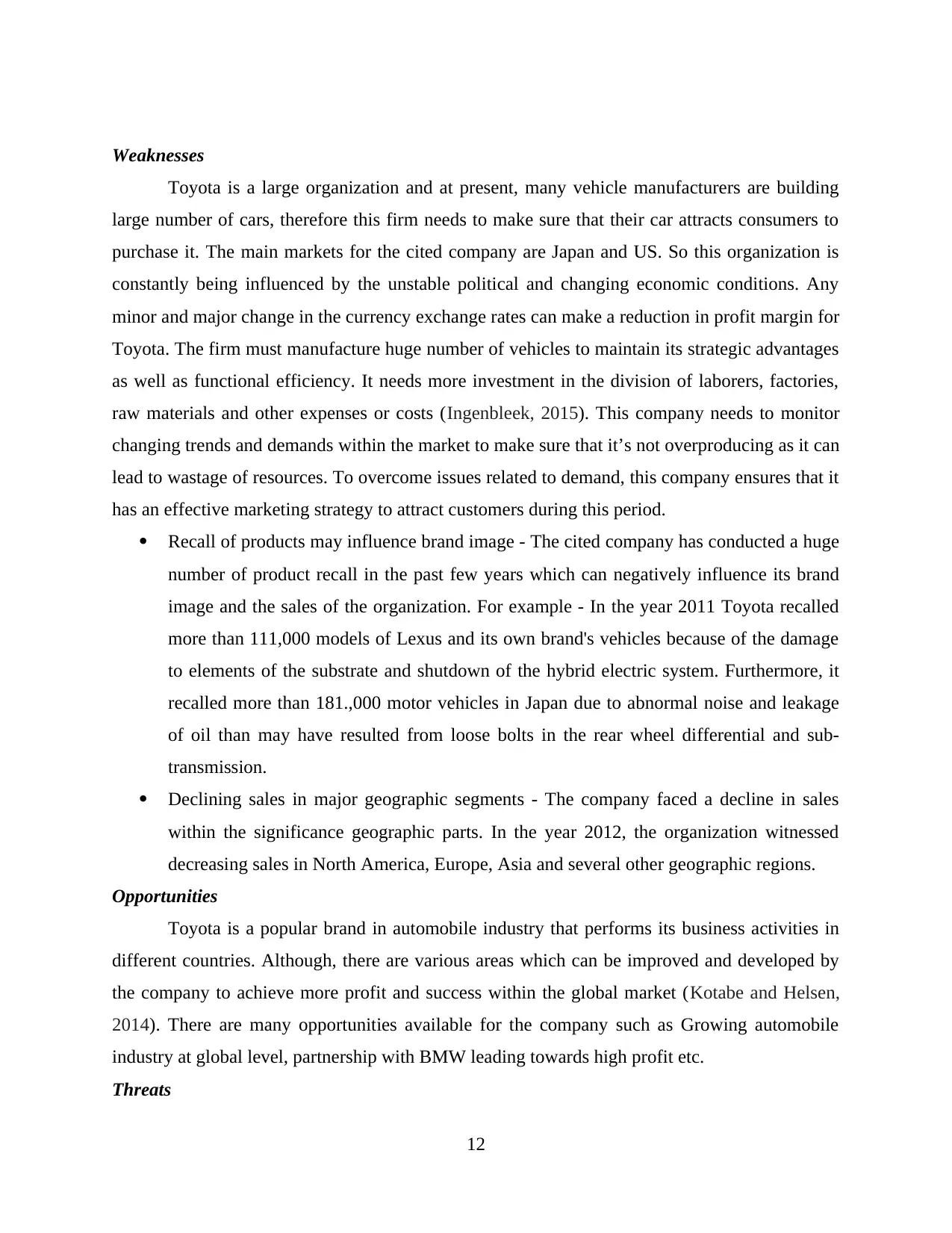
Weaknesses
Toyota is a large organization and at present, many vehicle manufacturers are building
large number of cars, therefore this firm needs to make sure that their car attracts consumers to
purchase it. The main markets for the cited company are Japan and US. So this organization is
constantly being influenced by the unstable political and changing economic conditions. Any
minor and major change in the currency exchange rates can make a reduction in profit margin for
Toyota. The firm must manufacture huge number of vehicles to maintain its strategic advantages
as well as functional efficiency. It needs more investment in the division of laborers, factories,
raw materials and other expenses or costs (Ingenbleek, 2015). This company needs to monitor
changing trends and demands within the market to make sure that it’s not overproducing as it can
lead to wastage of resources. To overcome issues related to demand, this company ensures that it
has an effective marketing strategy to attract customers during this period.
Recall of products may influence brand image - The cited company has conducted a huge
number of product recall in the past few years which can negatively influence its brand
image and the sales of the organization. For example - In the year 2011 Toyota recalled
more than 111,000 models of Lexus and its own brand's vehicles because of the damage
to elements of the substrate and shutdown of the hybrid electric system. Furthermore, it
recalled more than 181.,000 motor vehicles in Japan due to abnormal noise and leakage
of oil than may have resulted from loose bolts in the rear wheel differential and sub-
transmission.
Declining sales in major geographic segments - The company faced a decline in sales
within the significance geographic parts. In the year 2012, the organization witnessed
decreasing sales in North America, Europe, Asia and several other geographic regions.
Opportunities
Toyota is a popular brand in automobile industry that performs its business activities in
different countries. Although, there are various areas which can be improved and developed by
the company to achieve more profit and success within the global market (Kotabe and Helsen,
2014). There are many opportunities available for the company such as Growing automobile
industry at global level, partnership with BMW leading towards high profit etc.
Threats
12
Toyota is a large organization and at present, many vehicle manufacturers are building
large number of cars, therefore this firm needs to make sure that their car attracts consumers to
purchase it. The main markets for the cited company are Japan and US. So this organization is
constantly being influenced by the unstable political and changing economic conditions. Any
minor and major change in the currency exchange rates can make a reduction in profit margin for
Toyota. The firm must manufacture huge number of vehicles to maintain its strategic advantages
as well as functional efficiency. It needs more investment in the division of laborers, factories,
raw materials and other expenses or costs (Ingenbleek, 2015). This company needs to monitor
changing trends and demands within the market to make sure that it’s not overproducing as it can
lead to wastage of resources. To overcome issues related to demand, this company ensures that it
has an effective marketing strategy to attract customers during this period.
Recall of products may influence brand image - The cited company has conducted a huge
number of product recall in the past few years which can negatively influence its brand
image and the sales of the organization. For example - In the year 2011 Toyota recalled
more than 111,000 models of Lexus and its own brand's vehicles because of the damage
to elements of the substrate and shutdown of the hybrid electric system. Furthermore, it
recalled more than 181.,000 motor vehicles in Japan due to abnormal noise and leakage
of oil than may have resulted from loose bolts in the rear wheel differential and sub-
transmission.
Declining sales in major geographic segments - The company faced a decline in sales
within the significance geographic parts. In the year 2012, the organization witnessed
decreasing sales in North America, Europe, Asia and several other geographic regions.
Opportunities
Toyota is a popular brand in automobile industry that performs its business activities in
different countries. Although, there are various areas which can be improved and developed by
the company to achieve more profit and success within the global market (Kotabe and Helsen,
2014). There are many opportunities available for the company such as Growing automobile
industry at global level, partnership with BMW leading towards high profit etc.
Threats
12

Increasing competition and natural disasters may be the major threats for Toyota, due to
enhancing number of competitors in the global market it could face major loss in market shares
and level of sales or profit. Probability of natural disasters in Japan is very high which can also
affect the overall functioning of the cited organization.
MARKETING MIX ACTIONS FOR TOYOTA
Toyota Motor Corporation is one of the biggest car manufacturers all around the world,
and has warehouses in different countries. This company uses various tools and methods to gain
competitive advantages to compete with other brands in global market.
Marketing mix is one of those essential methodologies which assist organization to
achieve high visibility and profit in the targeted market. Marketing mix mainly consist sof 4 P's
which can be described as below -
13
Illustration 3: Marketing mix
(Source:Marketing mix, 2017)
enhancing number of competitors in the global market it could face major loss in market shares
and level of sales or profit. Probability of natural disasters in Japan is very high which can also
affect the overall functioning of the cited organization.
MARKETING MIX ACTIONS FOR TOYOTA
Toyota Motor Corporation is one of the biggest car manufacturers all around the world,
and has warehouses in different countries. This company uses various tools and methods to gain
competitive advantages to compete with other brands in global market.
Marketing mix is one of those essential methodologies which assist organization to
achieve high visibility and profit in the targeted market. Marketing mix mainly consist sof 4 P's
which can be described as below -
13
Illustration 3: Marketing mix
(Source:Marketing mix, 2017)
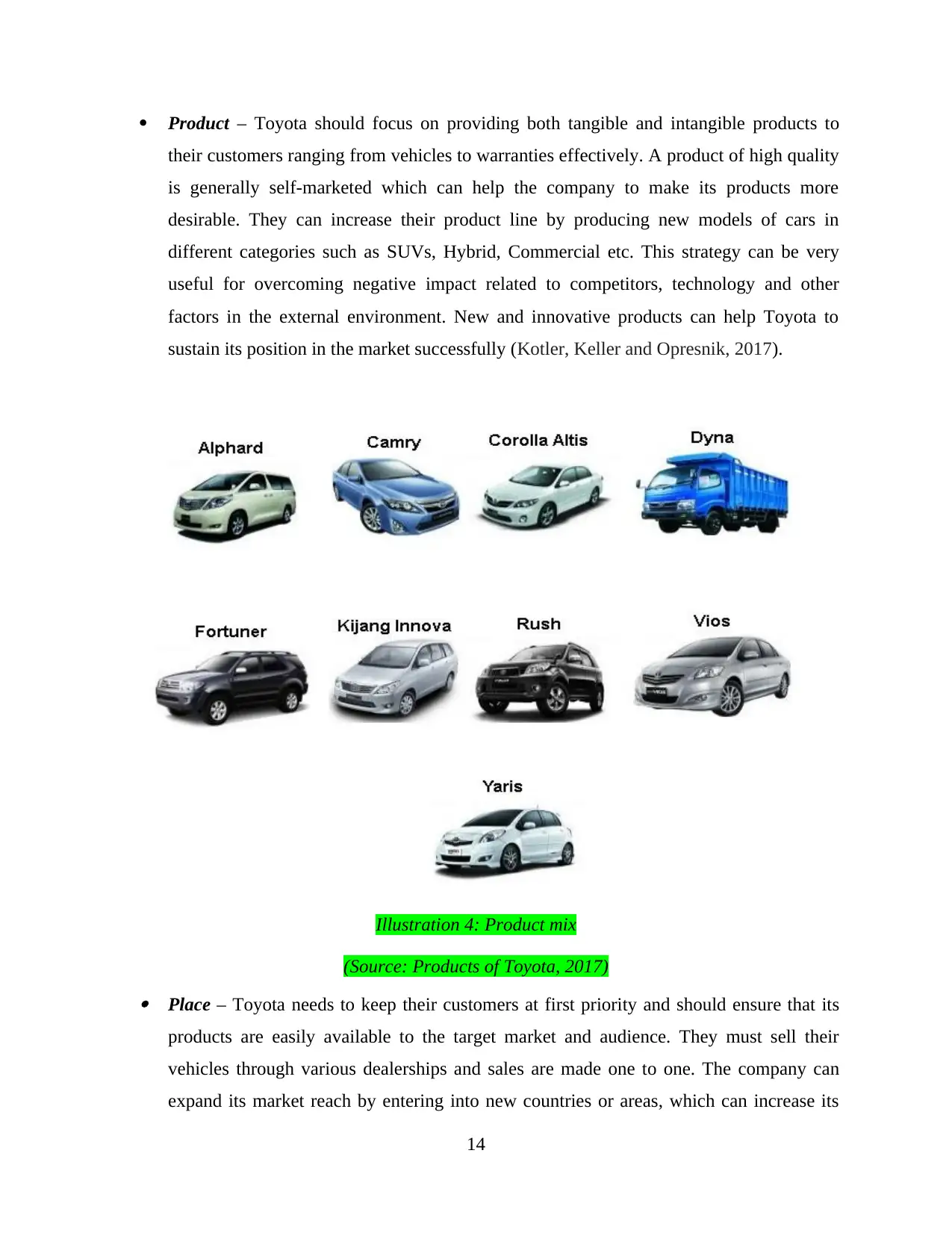
Product – Toyota should focus on providing both tangible and intangible products to
their customers ranging from vehicles to warranties effectively. A product of high quality
is generally self-marketed which can help the company to make its products more
desirable. They can increase their product line by producing new models of cars in
different categories such as SUVs, Hybrid, Commercial etc. This strategy can be very
useful for overcoming negative impact related to competitors, technology and other
factors in the external environment. New and innovative products can help Toyota to
sustain its position in the market successfully (Kotler, Keller and Opresnik, 2017).
Place – Toyota needs to keep their customers at first priority and should ensure that its
products are easily available to the target market and audience. They must sell their
vehicles through various dealerships and sales are made one to one. The company can
expand its market reach by entering into new countries or areas, which can increase its
14
Illustration 4: Product mix
(Source: Products of Toyota, 2017)
their customers ranging from vehicles to warranties effectively. A product of high quality
is generally self-marketed which can help the company to make its products more
desirable. They can increase their product line by producing new models of cars in
different categories such as SUVs, Hybrid, Commercial etc. This strategy can be very
useful for overcoming negative impact related to competitors, technology and other
factors in the external environment. New and innovative products can help Toyota to
sustain its position in the market successfully (Kotler, Keller and Opresnik, 2017).
Place – Toyota needs to keep their customers at first priority and should ensure that its
products are easily available to the target market and audience. They must sell their
vehicles through various dealerships and sales are made one to one. The company can
expand its market reach by entering into new countries or areas, which can increase its
14
Illustration 4: Product mix
(Source: Products of Toyota, 2017)
Secure Best Marks with AI Grader
Need help grading? Try our AI Grader for instant feedback on your assignments.

distribution channels by including numerous retailers from new markets. It should also
follow door to door sales in countries such as US, UK etc, apart from Japan to increase
product awareness in other markets as well. Entering into undeveloped nations can be
much easier than their policies related to business are not strict. This company tries to
develop new markets with their strategies and increase number of distribution channels
(Lindgreen and Di Benedetto, 2017).
Pricing – The selling price of each and every product is generally stated by the profit
earned and cost price together. The increment in cost of production is passed directly
towards customers with regards to the selling price. Toyota utilizes a unique approach;
they compute the profit rather than calculating the selling price of the products. Pricing
products with respect to the products and target market can be very helpful to achieve
higher revenue.
Promotion – Promotion and advertising is also one of the most important parts for
companies which can develop various unique commercials for their products. Recently,
Toyota created an interesting advertisement for their new car Prius, which said it has
lower emission then a goat. In this way, Toyota can use various innovative advertising
methods to attract customers in various markets and segments (Marshall, 2014).
15Illustration 5: Promotional Ad – Toyota
(Source:Promotion of Toyota, 2016)
follow door to door sales in countries such as US, UK etc, apart from Japan to increase
product awareness in other markets as well. Entering into undeveloped nations can be
much easier than their policies related to business are not strict. This company tries to
develop new markets with their strategies and increase number of distribution channels
(Lindgreen and Di Benedetto, 2017).
Pricing – The selling price of each and every product is generally stated by the profit
earned and cost price together. The increment in cost of production is passed directly
towards customers with regards to the selling price. Toyota utilizes a unique approach;
they compute the profit rather than calculating the selling price of the products. Pricing
products with respect to the products and target market can be very helpful to achieve
higher revenue.
Promotion – Promotion and advertising is also one of the most important parts for
companies which can develop various unique commercials for their products. Recently,
Toyota created an interesting advertisement for their new car Prius, which said it has
lower emission then a goat. In this way, Toyota can use various innovative advertising
methods to attract customers in various markets and segments (Marshall, 2014).
15Illustration 5: Promotional Ad – Toyota
(Source:Promotion of Toyota, 2016)

All the above marketing mix actions may help the auto-mobile company to overcome
negative impact of various external environmental factors, Effective pricing with respect to new
marketing mix actions can help in gaining competitive advantage among its competitors. The
new marketing mix is more effective as it can assist Toyota to target new market for more
growth and enhanced level of profitability.
CONCLUSION
The above report concluded that marketing is an essential tool for any company which
can be used to increase market growth and profit. It can be determined from this study that
Toyota has achieved a leading market position due to effective marketing strategies. The
company utilizes both low cost and differentiation general strategies to obtain a competitive
advantage over their competitors within this automobile industry. Furthermore, the report also
includes new marketing mix actions such as pricing, products, promotion and place which can be
helpful for Toyota in achieving high profitability in global market.
16
negative impact of various external environmental factors, Effective pricing with respect to new
marketing mix actions can help in gaining competitive advantage among its competitors. The
new marketing mix is more effective as it can assist Toyota to target new market for more
growth and enhanced level of profitability.
CONCLUSION
The above report concluded that marketing is an essential tool for any company which
can be used to increase market growth and profit. It can be determined from this study that
Toyota has achieved a leading market position due to effective marketing strategies. The
company utilizes both low cost and differentiation general strategies to obtain a competitive
advantage over their competitors within this automobile industry. Furthermore, the report also
includes new marketing mix actions such as pricing, products, promotion and place which can be
helpful for Toyota in achieving high profitability in global market.
16

REFERENCES
Books and Journals
Arkadan, F., Macdonald, E.K. and Wilson, H.N., 2017. A Systematic Literature Review of
Practices in Customer Experience Management: An Abstract. In Marketing at the
Confluence between Entertainment and Analytics (pp. 475-475). Springer, Cham.
Bagozzi, R.P., Rosa, J.A., Celly, K.S. and Coronel, F., 2018.Marketing-Management. Walter de
Gruyter GmbH & Co KG.
Bresler, M. and Lubbe, I., 2014. Marketing management.
Chernev, A., 2018. Strategic marketing management. Cerebellum Press.
Chernev, A., 2018. Strategic marketing management. Cerebellum Press.
Fotiadis, T. and Folinas, D., 2017. Marketing and Supply Chain Management: A Systemic
Approach. Routledge.
Foxall, G., 2014. Strategic Marketing Management (RLE Marketing). Routledge.
Huang, J., Guo, P., Xie, Q. and Meng, X., 2015. Cloud services platform based on big data
analytics and its application in livestock management and marketing. Proceedings of
science.
Hutchinson, K., Donnell, L.V., Gilmore, A. and Reid, A., 2015. Loyalty card adoption in SME
retailers: the impact upon marketing management. European Journal of
Marketing, 49(3/4), pp.467-490.
Ingenbleek, P.T., Meulenberg, M.T. and Van Trijp, H.C., 2015. Buyer social responsibility: A
general concept and its implications for marketing management. Journal of Marketing
Management, 31(13-14), pp.1428-1448.
Islam, F.R. and Mamun, K.A., 2017. Possibilities and Challenges of Implementing Renewable
Energy in the Light of PESTLE & SWOT Analyses for Island Countries. In Smart
Energy Grid Design for Island Countries (pp. 1-19). Springer, Cham.
Kotabe, M. and Helsen, K., 2014. Global marketing management.
Kotler, P., Keller, K.L. and Opresnik, M.O., 2017. Marketing-Management: Konzepte-
Instrumente-Unternehmensfallstudien. Pearson Deutschland GmbH.
Lindgreen, A. and Di Benedetto, C.A., 2017. The future of Industrial Marketing Management.
Marinchak, C.M., Forrest, E. and Hoanca, B., 2018. Artificial Intelligence: Redefining
Marketing Management and the Customer Experience. International Journal of E-
Entrepreneurship and Innovation (IJEEI), 8(2), pp.14-24.
17
Books and Journals
Arkadan, F., Macdonald, E.K. and Wilson, H.N., 2017. A Systematic Literature Review of
Practices in Customer Experience Management: An Abstract. In Marketing at the
Confluence between Entertainment and Analytics (pp. 475-475). Springer, Cham.
Bagozzi, R.P., Rosa, J.A., Celly, K.S. and Coronel, F., 2018.Marketing-Management. Walter de
Gruyter GmbH & Co KG.
Bresler, M. and Lubbe, I., 2014. Marketing management.
Chernev, A., 2018. Strategic marketing management. Cerebellum Press.
Chernev, A., 2018. Strategic marketing management. Cerebellum Press.
Fotiadis, T. and Folinas, D., 2017. Marketing and Supply Chain Management: A Systemic
Approach. Routledge.
Foxall, G., 2014. Strategic Marketing Management (RLE Marketing). Routledge.
Huang, J., Guo, P., Xie, Q. and Meng, X., 2015. Cloud services platform based on big data
analytics and its application in livestock management and marketing. Proceedings of
science.
Hutchinson, K., Donnell, L.V., Gilmore, A. and Reid, A., 2015. Loyalty card adoption in SME
retailers: the impact upon marketing management. European Journal of
Marketing, 49(3/4), pp.467-490.
Ingenbleek, P.T., Meulenberg, M.T. and Van Trijp, H.C., 2015. Buyer social responsibility: A
general concept and its implications for marketing management. Journal of Marketing
Management, 31(13-14), pp.1428-1448.
Islam, F.R. and Mamun, K.A., 2017. Possibilities and Challenges of Implementing Renewable
Energy in the Light of PESTLE & SWOT Analyses for Island Countries. In Smart
Energy Grid Design for Island Countries (pp. 1-19). Springer, Cham.
Kotabe, M. and Helsen, K., 2014. Global marketing management.
Kotler, P., Keller, K.L. and Opresnik, M.O., 2017. Marketing-Management: Konzepte-
Instrumente-Unternehmensfallstudien. Pearson Deutschland GmbH.
Lindgreen, A. and Di Benedetto, C.A., 2017. The future of Industrial Marketing Management.
Marinchak, C.M., Forrest, E. and Hoanca, B., 2018. Artificial Intelligence: Redefining
Marketing Management and the Customer Experience. International Journal of E-
Entrepreneurship and Innovation (IJEEI), 8(2), pp.14-24.
17
Paraphrase This Document
Need a fresh take? Get an instant paraphrase of this document with our AI Paraphraser
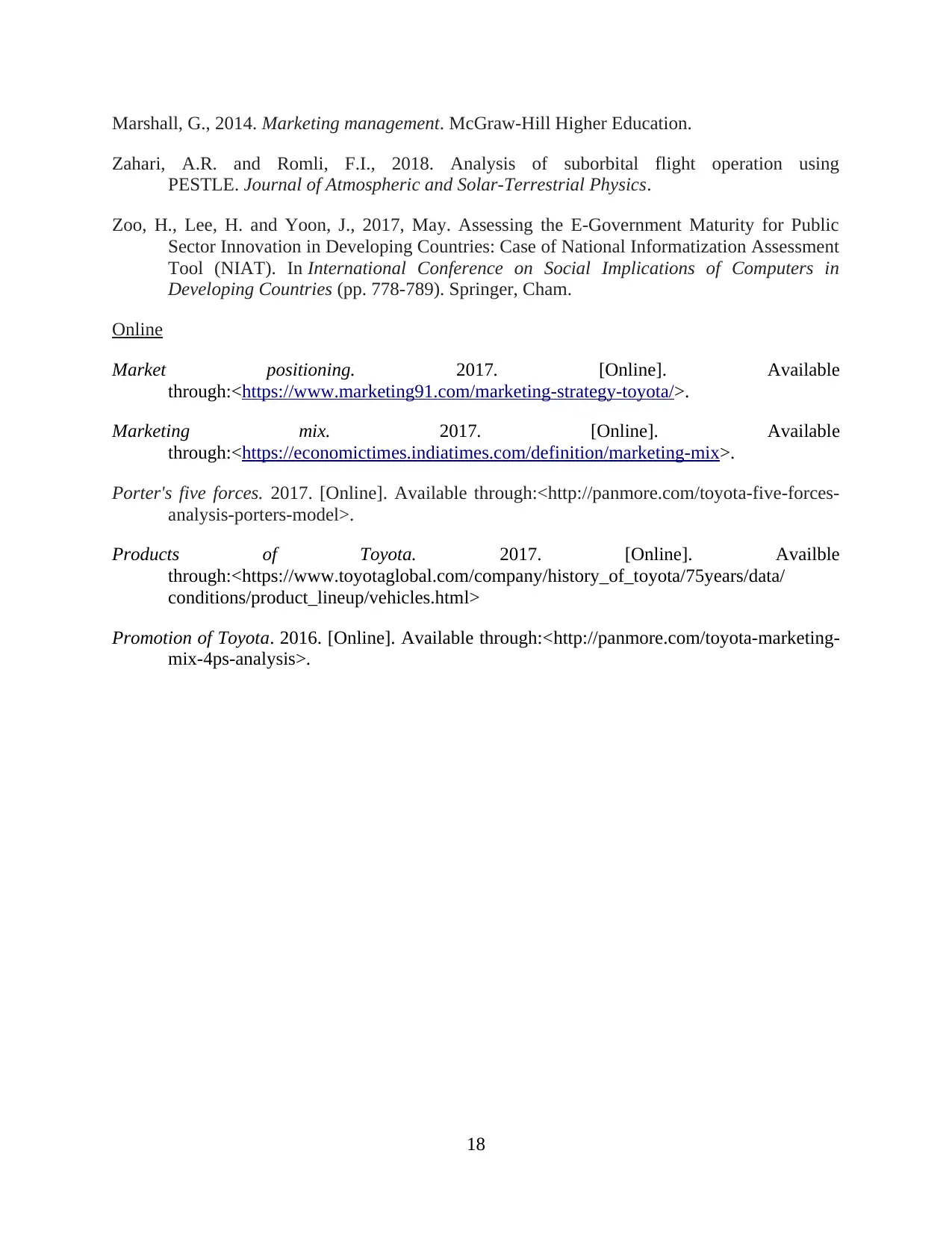
Marshall, G., 2014. Marketing management. McGraw-Hill Higher Education.
Zahari, A.R. and Romli, F.I., 2018. Analysis of suborbital flight operation using
PESTLE. Journal of Atmospheric and Solar-Terrestrial Physics.
Zoo, H., Lee, H. and Yoon, J., 2017, May. Assessing the E-Government Maturity for Public
Sector Innovation in Developing Countries: Case of National Informatization Assessment
Tool (NIAT). In International Conference on Social Implications of Computers in
Developing Countries (pp. 778-789). Springer, Cham.
Online
Market positioning. 2017. [Online]. Available
through:<https://www.marketing91.com/marketing-strategy-toyota/>.
Marketing mix. 2017. [Online]. Available
through:<https://economictimes.indiatimes.com/definition/marketing-mix>.
Porter's five forces. 2017. [Online]. Available through:<http://panmore.com/toyota-five-forces-
analysis-porters-model>.
Products of Toyota. 2017. [Online]. Availble
through:<https://www.toyotaglobal.com/company/history_of_toyota/75years/data/
conditions/product_lineup/vehicles.html>
Promotion of Toyota. 2016. [Online]. Available through:<http://panmore.com/toyota-marketing-
mix-4ps-analysis>.
18
Zahari, A.R. and Romli, F.I., 2018. Analysis of suborbital flight operation using
PESTLE. Journal of Atmospheric and Solar-Terrestrial Physics.
Zoo, H., Lee, H. and Yoon, J., 2017, May. Assessing the E-Government Maturity for Public
Sector Innovation in Developing Countries: Case of National Informatization Assessment
Tool (NIAT). In International Conference on Social Implications of Computers in
Developing Countries (pp. 778-789). Springer, Cham.
Online
Market positioning. 2017. [Online]. Available
through:<https://www.marketing91.com/marketing-strategy-toyota/>.
Marketing mix. 2017. [Online]. Available
through:<https://economictimes.indiatimes.com/definition/marketing-mix>.
Porter's five forces. 2017. [Online]. Available through:<http://panmore.com/toyota-five-forces-
analysis-porters-model>.
Products of Toyota. 2017. [Online]. Availble
through:<https://www.toyotaglobal.com/company/history_of_toyota/75years/data/
conditions/product_lineup/vehicles.html>
Promotion of Toyota. 2016. [Online]. Available through:<http://panmore.com/toyota-marketing-
mix-4ps-analysis>.
18
1 out of 20
Related Documents
Your All-in-One AI-Powered Toolkit for Academic Success.
+13062052269
info@desklib.com
Available 24*7 on WhatsApp / Email
![[object Object]](/_next/static/media/star-bottom.7253800d.svg)
Unlock your academic potential
© 2024 | Zucol Services PVT LTD | All rights reserved.





